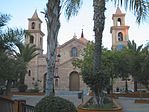Torrevieja
This article needs additional citations for verification. (September 2012) |
Torrevieja Torrevella | |
|---|---|
| Country | |
| Autonomous community | |
| Province | Alicante |
| Comarca | Baix Segura |
| Judicial district | Torrevieja |
| Founded | 20th century |
| Government | |
| • Mayor | Marcos Silvo Nogales(2011)[1] (PP) |
| Area | |
| • Total | 71.44 km2 (27.58 sq mi) |
| Elevation | 7 m (23 ft) |
| Population (2009) | |
| • Total | 101,792 |
| • Density | 1,400/km2 (3,700/sq mi) |
| Demonym | Torrevejense |
| Time zone | UTC+1 (CET) |
| • Summer (DST) | UTC+2 (CEST) |
| Postal code | 03181 a 03188 |
| Dialing code | 965 and 966 |
| Official language(s) | Spanish |
| Website | www.torrevieja.es |
Torrevieja (Spanish pronunciation: [toreˈβjexa], Valencian: [Torrevella] Error: {{Lang}}: text has italic markup (help) [toreˈveʎa])[2] is a seaside city and municipality located on the Costa Blanca in the province of Alicante, in south-eastern Spain.
Torrevieja lies about 30 miles south of the city of Alicante and has a population of 104,000 (2008). Torrevieja was originally a salt-mining and fishing village as it is located between the sea and two large salt lakes (Las Salinas), which give Torrevieja a healthy micro climate.
History
Until 1802, Torrevieja existed only as an ancient guard tower, which gave the town its name (Torre Vieja (Spanish) means Old Tower) and some labourers' cottages. But in 1803, Charles IV authorized the movement of the salt production offices from La Mata to the town itself and allowed the construction of dwellings there. In 1829, the town was totally destroyed by an earthquake, but the basins were soon reconstructed and re-opened. In 1931, Alfonso XIII gave Torrevieja city status by special grant. During this period, there was also a growing market for flax, hemp and cotton.
In the 19th century, the salt was mainly shipped from the town by Swedish and Dutch ships. At the time, there was only limited demand from other regions of Spain, mainly Galicia and to a lesser extent, Valencia. Although by the dawn of the 20th century, a quarter of all the salt harvested from the lagoon in Torrevieja was sold in Spain itself, and the rest exported was to foreign markets. Today, it is still an important industry in Torrevieja and a major employer. You can visit the Museum of Sea and Salt.
Recent

In recent years the local economy has hugely expanded due to the tourist industry. This includes both a strong contingent of British, Irish, Germans and Scandinavians, many of whom live there all the year round, and Spanish people who have a second home in the city. By 2004, Torrevieja had the largest number of British residents of all the Spanish municipalities (approx. 7,180), and that figure has now exceeded 12,000.[citation needed] The high number of British expatriates has led Torrevieja being nicknamed as 'the costa del Yorkshire' by some holidaymakers, often surprised that many British residents prefer imported cheap mass-produced bread from England such as Warburtons and Hovis. The city is a conservative stronghold, with the Partido Popular maintaining an absolute majority at the municipal elections of 27 May 2007.
Since 2001, the city's authorities along with Random House's Spanish subsidiary, Plaza & Janés, award Spain's second most important annual literary award, the Premio de Novela Ciudad de Torrevieja, and its poetry correlative, Premio de Poesía Ciudad de Torrevieja.
Population
The INE (Spanish Census) of 2005 showed that the city had 84,838 residents, and the ayuntamiento (district council area) had 95,531 residents. By January 2008 this figure had reached 103,154 of which only 47,870 were Spanish. 7,000+ of the Spanish residents were originally from Madrid and not for nothing is Torrevieja known as "la playa de Madrid" (The Madrid Beach). The most prominent nationalities in 2005 were:
| Nationality | Percentage | Nationality | Percentage | |
|---|---|---|---|---|
| Spanish | 47.80 | Colombian | 2.58 | |
| British | 13.30 | Ukrainian | 2.24 | |
| German | 5.15 | Moroccan | 2.17 | |
| Swedish | 3.14 | Norwegian | 2.17 | |
| Russian | 2.73 | Other | 13.30 |
| Year | 1897 | 1910 | 1930 | 1950 | 1960 | 1970 | 1980 | 1991 | 1996 | 2001 | 2004 | 2005 |
|---|---|---|---|---|---|---|---|---|---|---|---|---|
| Population | 7,833 | 8,961 | 8,754 | 8,935 | 9,234 | 9,726 | 12,314 | 25,014 | 35,998 | 50,953 | 75,530 | 84,348 |
Places of interest
- Iglesia Arciprestal de la Inmaculada Concepción - Originally erected in 1789 and then reconstructed in 1844, using stones reclaimed from the original Torre Vieja, (Old Tower).
- Iglesia de Nuestra Señora del Rosario (La Mata), constructed in 1896.
- Paseo de la Dique de Levante
- Parque de las Naciones or The Park of the Nations


- Museo del Mar y de la Sal (Sea and Salt Museum)
- Submarine S61 Delfin
- Las Salinas - The salt lakes to the west of the city.
- The Market
- Centro Habaneras - A semi-outdoor shopping mall.
- Paraje Natural Municipal Molino Del Agua - A natural park.
- Old Railway Station
- Water Fountains
- Playa de Los Naufragos
- Aquapolis, Water Park
- Boom Boom st
- Carrefour Torrevieja (24hrs)
References
- ^ http://www.diarioinformacion.com/vega-baja/2011/05/24/quiera-trabajar-torrevieja-espacio-pleno-tender-mano/1130623.html
- ^ Although Torrevieja is in one of the Spanish-speaking areas of the Valencian Community, it also has the Valencian name Torrevella.
External links
- Torrevieja weather (Free Live Weather for Torrevieja}
- Official Website of Torrevieja Template:Es
 Torrevieja travel guide from Wikivoyage
Torrevieja travel guide from Wikivoyage


